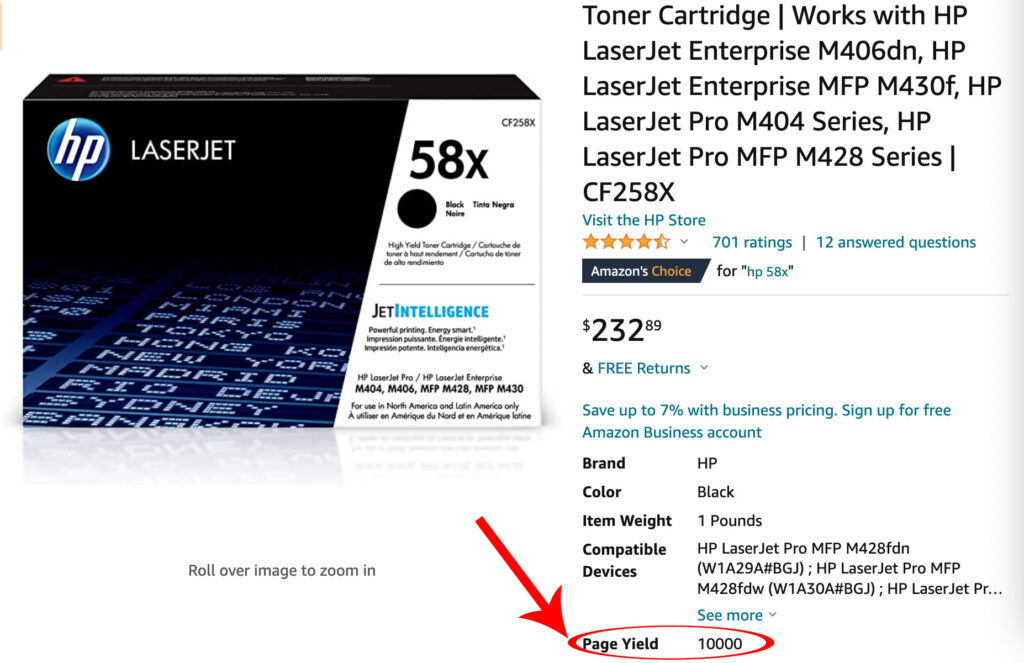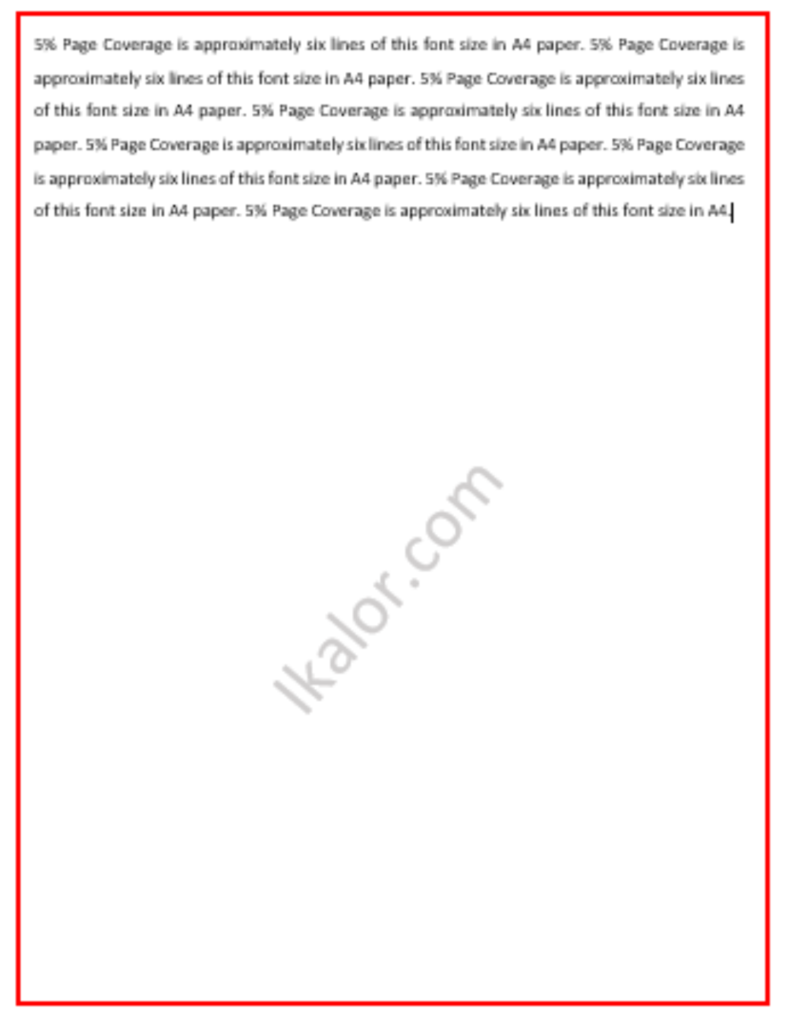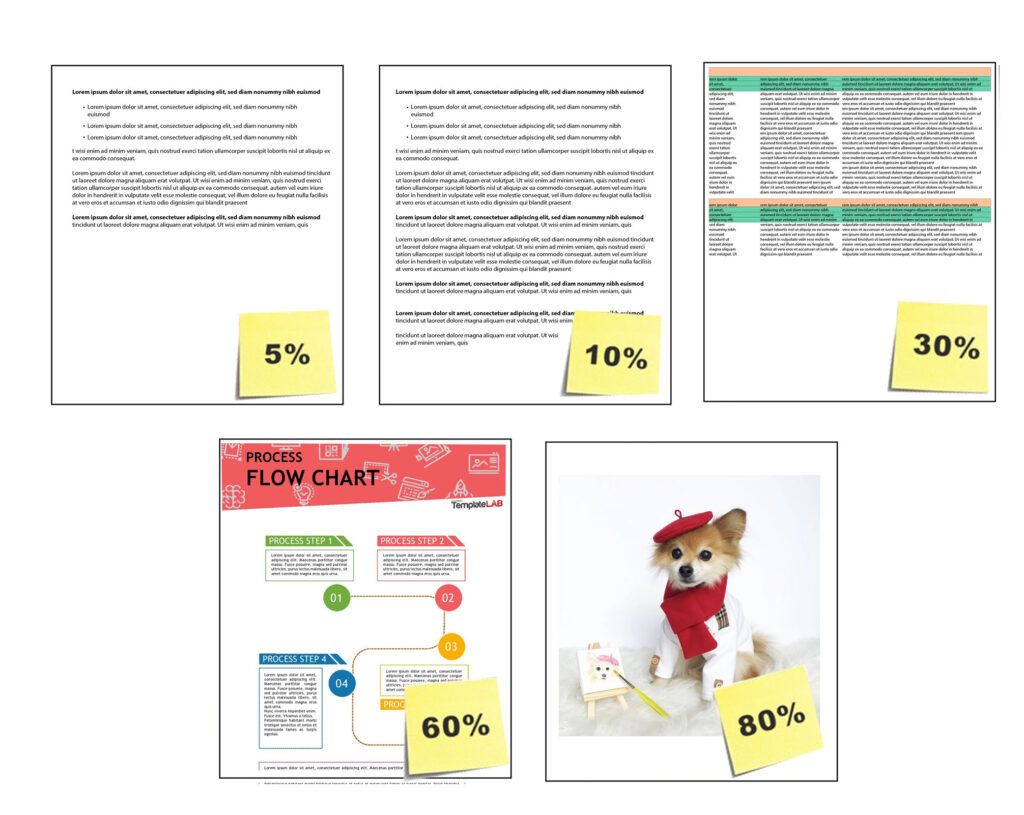Hầu hết người tiêu dùng đều thất vọng khi hộp mực của họ không sản xuất các trang được chỉ định. Họ cảm thấy bị lừa bởi nhà sản xuất. Điều đó thường không phải là trường hợp. Những người tiêu dùng này không đưa ra ý nghĩa bảo hiểm 5% trong bối cảnh sản lượng trang.
Đó là những gì chúng tôi trình bày trong bài viết hôm nay.
Bảo hiểm trang 5% là gì?
Các trang khác nhau có phạm vi bảo hiểm khác nhau. Ước tính năng suất trang hộp mực sẽ là thách thức mà không có bất kỳ tiêu chí nào. Sau đó, tổ chức tiêu chuẩn hóa quốc tế (ISO) đến để đặt tiêu chuẩn. Điều quan trọng là người tiêu dùng phải biết đầu ra mà họ có thể mong đợi từ hộp mực. Điều này sẽ cung cấp một cơ sở cho việc ra quyết định trên hộp mực để mua.

Ủy ban ISO đồng ý rằng nội dung bao gồm 5% sẽ bằng một trang. Điều này ngụ ý rằng mực hoặc mực nên bao gồm 5% trang. 95% khác phải là không gian trắng. Phạm vi bảo hiểm 5% này bị ảnh hưởng bởi một số yếu tố, chẳng hạn như loại phông chữ và kích thước. Chúng tôi sẽ xem xét các yếu tố đó sau trong bài đăng này.
Phạm vi bảo hiểm khác nhau cho văn bản, bảng tính, và hình ảnh.
Làm thế nào để một phạm vi bảo hiểm trang 5% nhìn vào văn bản
Bảo hiểm trang 5% là khoảng sáu dòng văn bản trong một bài báo A4. Phạm vi bảo hiểm có thể thay đổi tùy thuộc vào kích thước phông chữ và loại. Dưới đây là phạm vi bảo hiểm 5% trông như thế nào trên giấy A4.

Làm thế nào để bảo hiểm trang 5% nhìn vào bảng tính?
Khi nói đến bảng tính, Chín cột và 45 hàng sẽ chiếm 5,6% của một trang. Tương đương với 405 ô mà không có đường viền. Thêm đường viền cột và hàng sẽ tăng gấp đôi mức tiêu thụ mực hoặc mực. Nó sẽ chuyển sang phạm vi bảo hiểm trang 10,9%.
How Does a 5% Page Coverage Look in Photos ;
Hầu hết các nhà sản xuất hộp mực ảnh không nêu trang mang lại trên hộp mực của họ. Đó là bởi vì không có tiêu chuẩn được công nhận với in ảnh. In ảnh thường phụ thuộc vào kích thước và loại hình ảnh.
Ngay cả khi không có tiêu chuẩn, Chúng ta vẫn có thể nói chuyện từ kinh nghiệm 10 năm của chúng ta trong ngành in ấn. Dưới đây là phạm vi bảo hiểm ảnh 5% trông giống như khi được in trên giấy A4:

Bảo hiểm trang và năng suất trang
Hầu hết các nhà sản xuất trích dẫn sản lượng trang của hộp mực của họ dựa trên phạm vi bảo hiểm 5%. Một số sử dụng bảo hiểm 10%, và logic là như nhau.

Nếu một hộp mực cung cấp năng suất 1600 trang trên phạm vi bảo hiểm 5% trang, Nó tạo ra 800 trên phạm vi bảo hiểm 10%. Tương tự, Nó sẽ in 400 trang với nội dung bao gồm 20% trang. Đó là lý do tại sao bạn khó có thể nhận được số chính xác được chỉ định trong hộp mực. In ấn hàng ngày của bạn có phạm vi bảo hiểm khác nhau.
Nếu bạn liên tục in phạm vi bảo hiểm trang 20%, Bạn sẽ chỉ đạt được một phần tư năng suất trang được chỉ định. Người tiêu dùng không hiểu về những điều này có xu hướng buộc tội nhà cung cấp hoặc nhà sản xuất của họ. Họ sẽ nghĩ rằng họ bị lừa và các hộp mực của họ không cung cấp những gì nó hứa hẹn.
Hãy để tính năng một ví dụ:
Cái nào tốt hơn giữa (MỘT) Năng suất 3200 trang trên phạm vi bảo hiểm 5% và (B) 2400 trên phạm vi bảo hiểm 10%?
Nếu bạn vội vàng vượt qua nó, Bạn có thể giải quyết với tùy chọn đầu tiên, Và bạn đã sai. Hộp mực a, cung cấp năng suất 3200 trang trên phạm vi bảo hiểm 5%, sẽ cung cấp 1600 trang trên phạm vi bảo hiểm 10%. Đây là ít hơn 2400, Hộp mực B cung cấp trên cùng một trang bảo hiểm.
Bạn có thể dễ dàng chọn hộp mực sai nếu bạn không làm toán. Bạn cần liên tục nhấn vào phạm vi bảo hiểm trang trong khi đánh giá năng suất trang.
Phạm vi bảo hiểm trang, Khối lượng trang giấy, và chi phí trên mỗi trang
Phạm vi bảo hiểm trang không dừng trong việc cung cấp cho bạn sản lượng trang. Bạn có thể sử dụng cùng một thông tin để tính toán chi phí hộp mực trên mỗi trang. Điều này là cơ sở cho việc ra quyết định trên các hộp mực để mua. Bạn có thể phải đối mặt với một số lựa chọn thử thách trong khi mua sắm hộp mực.
Hãy cùng xem một số khả năng
- Hộp mực A sản xuất 3000 trang ở mức bảo hiểm 5% và chi phí $ 40
- Hộp mực B mang lại 1200 trang ở mức bảo hiểm 10% và chi phí $ 35
Cái nào cung cấp chi phí rẻ hơn trên mỗi trang?
Sẽ rất hữu ích khi làm một số toán học trước khi quyết định mua hộp mực để mua. Số có thể nói dối, Thỉnh thoảng.
Hãy để chạy một số tính toán và xem cái nào cung cấp chi phí in thấp hơn:
Bước một: Chuyển đổi sang phạm vi bảo hiểm cùng trang
- Hộp mực A = 3000 trang ở phạm vi bảo hiểm 5% trên trang
- Hộp mực B = 1200 trang ở độ bao phủ 10% trang = 2400 trang ở độ phủ 5% trang
Bước hai: làm toán

Điều này có nghĩa là hộp mực A cung cấp tỷ lệ in rẻ hơn. Bạn sẽ chi thêm $ 5 để lấy hộp mực, Nhưng cuối cùng bạn đã tận hưởng một bản in giá cả phải chăng hơn. Làm cho nó trở thành một thói quen để thực hiện tính toán của bạn trước khi mua hộp mực của bạn. Theo cách đó, Bạn đã kiếm được nhiều lợi nhuận hơn.
Các yếu tố ảnh hưởng đến phạm vi bảo hiểm trang 5%
Bạn có thể đang tự hỏi:
Các thiết kế của tôi dường như chiếm 5% của trang, Tuy nhiên, hộp mực của tôi vẫn không tồn tại như đã chỉ ra?
Đó là một mối quan tâm chung. Bạn có thể dính vào 5% hoặc 10% và vẫn in số lượng trang tương đối thấp. Hộp mực của bạn có thể kéo dài lâu hơn trong những dịp khác. Bạn có thể tự hỏi tại sao hộp mực của bạn thường không thể đoán trước được.
Động lực như vậy có thể không xảy ra dựa trên lý do của các nhà sản xuất. Hãy để xem xét một số yếu tố ảnh hưởng đến phạm vi bảo hiểm trang:
1. ;Loại phông chữ
Tiêu thụ mực khác nhau từ phông chữ đến phông chữ. Có những người có mực kinh tế. Những người khác không thương tiếc sử dụng mực như thể nó không phải là không có ai kinh doanh.
Nó đã được tìm thấy rằng các phông chữ serif có xu hướng tiêu thụ ít mực hơn so với sans serif. Điều này là do phông chữ serif có các đường mỏng. Phông chữ Gothic thế kỷ tiêu thụ ít nhất. Thế kỷ Gothic sẽ sử dụng ít mực/mực ít hơn tới 30% so với phông chữ Arial. Các phông chữ khác tiêu thụ ít hơn là calibri, Lần mới La Mã, và Verdani. Arial cũng sử dụng ít hơn so với nhiều người khác.
2. ;Kích thước phông chữ
Kích thước phông chữ cũng ảnh hưởng đến phạm vi bảo hiểm 5% và mức tiêu thụ mực. Sử dụng phông chữ lớn hơn sẽ tiêu thụ nhiều mực hơn những chiếc nhỏ hơn. Phạm vi bảo hiểm 5% của bạn sẽ ít hơn khi bạn sử dụng phông chữ lớn hơn. Tránh in phông chữ khổng lồ không cần thiết trừ khi nó cần thiết. ;
3. ;Trọng lượng phông chữ
Ký tự táo bạo tiêu thụ nhiều mực hơn. Máy in của bạn sẽ sử dụng nhiều mực hơn để làm cho chúng khác biệt với phần còn lại. Bạn nên giảm thiểu văn bản táo bạo nếu bạn đang in với ngân sách. Chữ nghiêng có thể không ảnh hưởng đến tiêu dùng. Bạn có thể nhấn vào tùy chọn này và in nghiêng những gì bạn muốn làm nổi bật. Mục tiêu không phải là loại bỏ hoàn toàn. Nó nhiều hơn về việc giảm sử dụng.
Các chiến lược để tận dụng tối đa mực của bạn
Hãy chú ý đến định dạng văn bản của bạn. Tránh các văn bản táo bạo hoặc gạch chân không cần thiết. Chữ nghiêng có thể phục vụ bạn tốt hơn

Chọn phông chữ của bạn với tiêu thụ mực trong tâm trí. Tránh những phông chữ với các đường dày. Kích thước phông chữ lớn hơn có thể không phục vụ bạn tốt, hoặc. ;
Suy nghĩ lại về nội dung trang của bạn. Làm cho hình ảnh của bạn nhỏ hơn nếu bạn phải bao gồm chúng. Làm cho những bảng đó không biên giới, miễn là chúng có thể đọc được.
Nghiên cứu trước khi mua máy in của bạn. Hộp mực cho máy in với trống sẵn có rẻ. Bạn có thể đầu tư vào những thứ đó và giảm chi phí in ấn. ;
Mua hộp mực tương thích cũng sẽ giúp. Chúng rẻ hơn các hộp mực ban đầu.
Đây là nơi Ikalor đến. Chúng tôi là một nhà sản xuất hộp mực tương thích có trụ sở tại Trung Quốc. Chúng tôi sản xuất và cung cấp sản phẩm của chúng tôi cho các nơi khác nhau trên thế giới. Bạn có thể nói chuyện với chúng tôi và có cơ hội để tận hưởng giá cả nhà máy.
